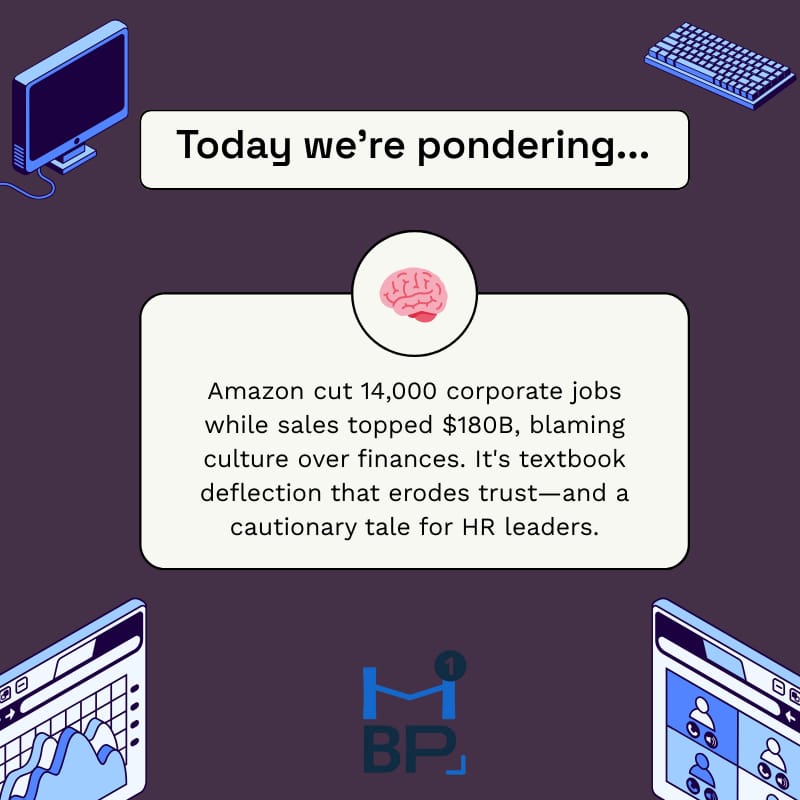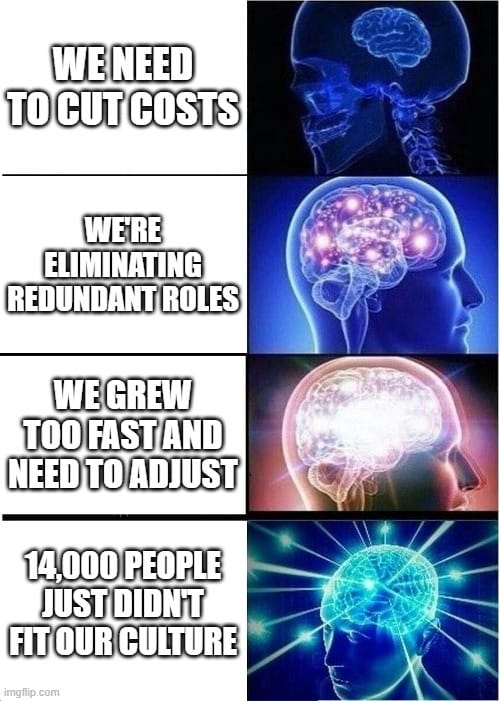- HR Brain Pickings
- Posts
- 🔍 Amazon's "Culture Cut": What HR Can Learn From Mass Layoffs
🔍 Amazon's "Culture Cut": What HR Can Learn From Mass Layoffs
When "cultural fit" becomes the scapegoat for strategic missteps 🔪

Today’s edition is presented by SelectSoftware Reviews
As a reader of HR Brain Pickings, you get free access to use SSR’s HR software matching service to find the best HRIS, ATS or Payroll software for your company.
How it works: An HR software advisor from SSR will tailor a vendor shortlist based on your unique needs, packaged with advice - saving you time and reducing your stress.
The best part? Their service is 100% free and rated 4.9/5 by HR teams.
Howdy HR friends!👋
Hope your Tuesday's treating you kindly (and your inbox isn't overflowing with "urgent" Slack messages... yet).
This week, we're unpacking Amazon's latest move: cutting 14,000 corporate jobs while posting record profits and blaming it all on "cultural fit." When a company nearly doubles its workforce in five years, then suddenly discovers a culture problem, HR professionals know there's more to the story.
We're breaking down the real takeaways HR can use to protect both your people and your credibility when leadership pivots. 🚩
👇️ Coming up
In today’s edition
🚩 When "Cultural Fit" Becomes Corporate Damage Control
🛋️ The Break Room: What's your take on Amazon blaming "cultural fit" for its mass layoffs?
📚 Human Readsources: AI's impact on workforce transformation, government efficiency initiatives disbanded, and major gender discrimination settlement updates.
💭 Opening thoughts
Is Amazon’s story just a drop in the pond?

What happens when a tech giant cuts 14,000 jobs while posting record profits, all while citing "cultural fit" as the primary reason?
Amazon's mass layoffs reveal a strategic pivot disguised as organizational pruning, with CEO Andy Jassy's comments about "excessive management layers" serving as corporate shorthand for fundamental business model recalibration.
HR professionals find themselves in the precarious position of implementing these workforce reductions while maintaining employee trust, essentially translating executive decisions into humane processes during what is clearly more than a simple cultural realignment.
In this analysis, we'll decode the real factors driving Amazon's workforce strategy, providing HR leaders with actionable insights on navigating similar organizational transformations without sacrificing authenticity or employee dignity.
For easy reading
🧠 Let’s unpick
🚩 When "Cultural Fit" Becomes Corporate Damage Control
Amazon's decision to cut 14,000 corporate employees while simultaneously posting record profits tells a story HR professionals know all too well.
While CEO Andy Jassy frames these layoffs as eliminating "excessive management layers" and slowing decision-making, the timing raises questions. The company nearly doubled its workforce since 2019 (from 798,000 to 1.5 million employees) and is now backpedaling on that growth.
Sound familiar? It's the classic case of aggressive hiring followed by "right-sizing" – except this time, culture is taking the blame instead of finances.
The messaging strategy here is particularly telling. Despite Amazon's Q3 sales topping $180 billion with a 38% profit increase, leadership chose to position this as a cultural correction rather than a financial necessity.
As HR Executive reports, this framing has sparked debate about who bears responsibility – the employees who supposedly didn't fit, or the hiring practices that brought them on board in the first place.
When companies blame "cultural mismatches" for mass layoffs, they're often deflecting accountability for strategic missteps in workforce planning.
For HR leaders navigating similar situations, transparency matters more than convenient narratives. If your organization is considering restructuring, resist the urge to scapegoat culture or individual employees for systemic planning issues.
Instead: 1) Own the strategic shifts driving the change, 2) Provide clear, honest communication about business reasons behind decisions, 3) Develop more robust workforce planning models that align hiring with sustainable growth trajectories, and 4) Remember that how you handle departures dramatically impacts both your employer brand and the morale of those who remain.
Your team deserves the truth, not corporate spin that undermines HR's credibility.
You can read more at...
🎬 Lights, camera, action!
Takeaway and try
Audit your hiring-to-layoff messaging for consistency—when you blame "cultural fit" for financial decisions, employees see right through it, and trust erodes fast.
Create transparent communication templates that honestly address business reasons behind restructuring instead of using culture as a convenient scapegoat.
Develop a proactive workforce planning model that flags unsustainable growth patterns before you're forced into reactive layoffs that damage morale and reputation.
Prepare leadership with talking points that acknowledge strategic missteps rather than implying employees somehow failed to fit in, especially when company profits are soaring.
Design an offboarding process that preserves dignity, offers meaningful support, and protects your employer brand—how you treat departing employees directly impacts those who remain.
👀Too long didn’t read
TLDR
Amazon's "culture" justification for cutting 14,000 jobs while posting record profits is corporate spin at its finest – a masterclass in deflecting accountability for aggressive hiring followed by convenient "right-sizing" that HR pros should recognize and resist.
☕The break room
What’s your take?

What's your take on Amazon blaming "cultural fit" for its mass layoffs? |
📚 Additional reading
Human Readsources
🤖 AI Reshaping Work: Tasks, Not Jobs, Disappearing (LinkedIn) - AI is reshaping jobs by automating routine tasks, not eliminating roles.
🪦 Trump's Efficiency Department Quietly Disbands (Reuters) - Trump's efficiency department disbanded after delivering few measurable savings.
⚖️ Ohio Firm Pays $2M for Gender Bias, Retaliation (HR Dive) - Ohio firm pays $2M for gender bias against women applicants.
That’s it for today.
Thanks for reading to the end and we hope today’s edition sparked some new ideas for your workplace! 🧠
We know you’re super busy and really appreciate you saving some room for us in your inbox 😀
On a scale of 1 to HR, how much do you like this edition? |
Reply